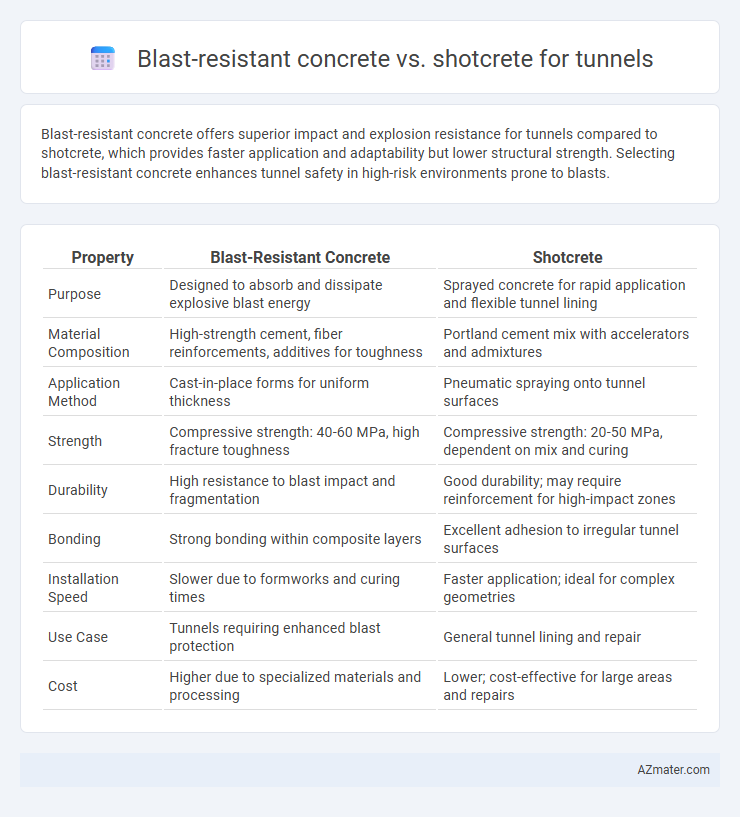Blast-resistant concrete offers superior impact and explosion resistance for tunnels compared to shotcrete, which provides faster application and adaptability but lower structural strength. Selecting blast-resistant concrete enhances tunnel safety in high-risk environments prone to blasts.
Table of Comparison
| Property | Blast-Resistant Concrete | Shotcrete |
|---|---|---|
| Purpose | Designed to absorb and dissipate explosive blast energy | Sprayed concrete for rapid application and flexible tunnel lining |
| Material Composition | High-strength cement, fiber reinforcements, additives for toughness | Portland cement mix with accelerators and admixtures |
| Application Method | Cast-in-place forms for uniform thickness | Pneumatic spraying onto tunnel surfaces |
| Strength | Compressive strength: 40-60 MPa, high fracture toughness | Compressive strength: 20-50 MPa, dependent on mix and curing |
| Durability | High resistance to blast impact and fragmentation | Good durability; may require reinforcement for high-impact zones |
| Bonding | Strong bonding within composite layers | Excellent adhesion to irregular tunnel surfaces |
| Installation Speed | Slower due to formworks and curing times | Faster application; ideal for complex geometries |
| Use Case | Tunnels requiring enhanced blast protection | General tunnel lining and repair |
| Cost | Higher due to specialized materials and processing | Lower; cost-effective for large areas and repairs |
Introduction to Tunnel Construction Methods
Tunnel construction methods often involve the use of specialized materials such as blast-resistant concrete and shotcrete to enhance structural integrity and safety. Blast-resistant concrete is engineered to withstand high-pressure shock waves from explosions, providing superior durability in tunnels exposed to potential blasts, while shotcrete--a sprayed concrete--offers rapid application and adaptability to complex tunnel geometries. Selection between these materials depends on factors like tunnel design requirements, anticipated load conditions, and construction speed.
Overview of Blast-Resistant Concrete
Blast-resistant concrete for tunnels is specially formulated to withstand high-pressure shock waves from explosions, featuring enhanced compressive strength, toughness, and ductility through additives like fibers and polymers. Unlike shotcrete, which is sprayed onto surfaces for adhesion and rapid setting, blast-resistant concrete integrates advanced mix designs and reinforcement to absorb and dissipate blast energy effectively. Its application increases tunnel safety by reducing structural damage and protecting against fragmentation and spalling during explosive events.
What is Shotcrete?
Shotcrete is a method of applying concrete projected at high velocity onto surfaces, commonly used for tunnel lining and rehabilitation due to its excellent adhesion and quick setting properties. It offers enhanced flexibility and can conform to complex geometries, making it ideal for irregular tunnel profiles compared to traditional blast-resistant concrete. Shotcrete also provides improved early strength development and reduces the need for formwork, accelerating construction timelines and ensuring safety in tunnel reinforcement.
Application Techniques: Cast-in-Place vs Sprayed Concrete
Blast-resistant concrete is typically applied using cast-in-place techniques, ensuring dense, high-strength layers capable of withstanding explosive forces in tunnel linings. Shotcrete, also known as sprayed concrete, is applied pneumatically, allowing rapid placement and adaptability to complex tunnel geometries, making it suitable for temporary support and reinforcement. The choice between cast-in-place and sprayed concrete depends on project requirements for structural integrity, installation speed, and ease of application in confined tunnel environments.
Structural Performance under Blast Loads
Blast-resistant concrete offers superior structural performance under blast loads due to its dense matrix and specialized mix design, which enhance energy absorption and reduce spall formation. Shotcrete provides rapid application and excellent adhesion in tunnels but may exhibit inferior resistance to intense blast pressures compared to engineered blast-resistant concrete formulations. Optimizing mix proportions and reinforcement in blast-resistant concrete ensures greater tunnel integrity and occupant safety during explosive events.
Durability and Longevity in Tunnel Environments
Blast-resistant concrete offers enhanced durability and longevity in tunnel environments by incorporating high-strength aggregates and admixtures that improve its resistance to explosive forces and chemical attack. Shotcrete provides rapid application and good initial strength but may exhibit reduced long-term durability under severe mechanical and environmental stresses commonly encountered in tunnels. For sustained performance in blast-prone tunnels, blast-resistant concrete ensures superior structural integrity and prolonged service life compared to traditional shotcrete methods.
Installation Speed and Cost Considerations
Blast-resistant concrete offers superior durability and protection but typically requires longer curing times and higher material costs compared to shotcrete. Shotcrete facilitates faster installation due to its spray application method, reducing labor hours and minimizing project timelines, making it more cost-effective for time-sensitive tunnel projects. Cost considerations must balance the initial expense of blast-resistant concrete against the accelerated construction schedule and labor savings afforded by shotcrete application.
Maintenance and Repair Challenges
Blast-resistant concrete offers superior durability and impact resistance compared to shotcrete, significantly reducing the frequency and extent of maintenance in tunnel applications. Shotcrete, while easier and faster to apply in situ, often requires more frequent repairs due to its lower resistance to blast loads and environmental degradation. Maintenance challenges with shotcrete include potential delamination and spalling, demanding continuous monitoring and patching to ensure tunnel safety and structural integrity.
Safety Standards and Regulatory Compliance
Blast-resistant concrete adheres to stringent safety standards such as ASTM E119 and EN 1992-1-1, ensuring high structural integrity against explosive forces in tunnel construction. Shotcrete, while versatile and quick to apply, must comply with specific regulations like ACI 506R for application techniques and thickness to meet safety criteria. Regulatory compliance for both materials involves rigorous testing for impact resistance, fire rating, and durability under extreme conditions to ensure tunnel safety and longevity.
Selecting the Optimal Material for Tunnel Projects
Blast-resistant concrete offers superior durability and energy absorption, making it ideal for tunnels exposed to high-impact or explosive forces. Shotcrete provides faster application and excellent adhesion on irregular surfaces, suitable for rapid tunnel stabilization. Selecting the optimal material depends on project-specific factors such as structural requirements, exposure conditions, and installation constraints.

Infographic: Blast-resistant concrete vs Shotcrete for Tunnel
 azmater.com
azmater.com